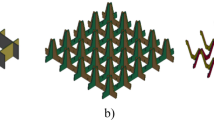Abstract
An analytical and non-linear finite element (FE) modelling approach of plain weave fabric reinforcements have been developed to predict shear force for pure shear condition. For simplicity two main components of force for shear deformation has been considered; one is force required for the elastic deformation and another is to overcome the frictional resistance. Coulomb friction model of ANSYS is used in the FE model whereas the boundary condition has been established using Lagrangian description. Modelling of frictional resistance due to contact between yarns and crossover are conducted by utilizing contact pair option in ANSYS. A good agreement between theoretical and FEA model have been obtained. To ensure pure shear deformation in the fabrics it has been proved that there are no stress (von Mises and normal) or tension exist in the deformed yarn.











Similar content being viewed by others
References
Long AC, Rudd CD, Blagdon M, Smith P (1996) Characterizing the processing and performance of aligned reinforcements during preform manufacture. Compos Part A 27:247–253
Boisse P, Zouari B, Daniel JL (2006) Importance of in-plane shear rigidity in finite element analyses of woven fabric composite performing. Compos Part A 37:2201–2212
Sun H, Pan N (2005) Shear deformation analysis for woven fabrics. Compos Struct 67:317–322
Launay J, Hivet G, Duong AV, Boisse P (2008) Experimental analysis of the influence of tensions on in plane shear behavior of woven composite reinforcements. Compos Sci Technol 68:506–515
Sharma SB, Sutcliffe MPF, Chang SH (2003) Characterization of material properties for draping of dry woven composite material. Compos Part A 34:1167–1175
Mohammed U, Lekakou C, Dong L, Bader MG (2000) Shear deformation and micromechanics of woven fabrics. Compos Part A 31:299–308
Daelemans L, Faes J, Allaoui S, Hivet G, Dierick M, Hoorebeke LV, Paepegem WV (2016) Finite element simulation of the woven geometry and mechanical behaviour of a 3D woven dry fabric under tensile and shear loading using the digital element method. Compos Sci Technol 137:177–187
Misra RK, Dixit A, Mali HS (2014) Finite element (FE) shear modeling of woven fabric textile composite. Proc Math Sci 6:1344–1350
Munro WA, Carnaby GA, Carr AJ, Moss PJ (1997) Some textile applications of finite-element analysis. J Text Inst 88:325–338
Hu JL, Zhang YT (1997) The KES shear test for fabrics. Text Res J 67:654–664
Asvadi S, Postle R (1994) An analysis of fabric large strain shear behavior using linear viscoelasticity theory. Text Res J 64:208–214
Kawabata S, Niwa M, Kawai H (1973) The finite deformation theory of plain-weave fabrics. Part III. The shear-deformation theory. Text Res J 64:62–85
Page J, Wang J (2000) Prediction of shear force and an analysis of yarn slippage for a plain-weave carbon fabric in a bias extension state. Compos Sci Technol 60:977–986
Sinoimeri A, Drean JY (1996) A study of the mechanical behavior of the plain-weave structure by using energy methods: fabric shear. J Text Inst 87:120–129
McGuiness GB, Bradaigh CM (1998) Characterisation of thermoplastic composite melts in rhombus-shear: the picture frame experiment. Compos Part A 29:115–132
Peng XQ, Cao J, Chen J, Xue P, Lussier DS, Liu L (2004) Experimental and numerical analysis on normalization of picture frame tests for composite materials. Compos Sci Technol 64:11–21
Cao J et al (2008) Characterization of mechanical behaviour of woven fabrics: experimental methods and benchmark results. Compos Part A 39:1037–1053
Lomov SV, Verpoest I (2006) Model of shear of woven fabric and parametric description of shear resistance of glass woven reinforcements. Compos Sci Technol 66:919–933
Hearle JWS, Grosberg P, Backer S (1969) Structural mechanics of fibers, Yarns & Fabrics. Wiley, New York
Afrashteh S, Merati AA, Jeddi AAAA (2013) Geometrical parameters of yarn cross-section in plain woven fabric. Indian J Fibre Text Res 38:126–131
Behera BK, Militky J, Mishra R, Kremenakova D (2012) Modeling of woven fabrics geometry and properties. http://cdn.intechopen.com/pdfs/36900.pdf. Accessed 16 May 2012
Ozgen B, Gong H (2010) Yarn geometry in woven fabrics. Text Res J 81:738–745
McBride M, Chen J (1997) Cell geometry in plain weave fabrics. Compos Sci Technol 51:345–351
Luo SY, Chou TW (1990) Finite deformation of composites. Proc R Soc Lond 429:569–586
Ramgulam RB, Potluri P, Ciurezu D (2008) Tensile & shear deformation modeling of woven fabrics. Int J Mater Form 1:945–948
Szablewski P, Kobza W (2003) Numerical analysis of Pierce’s cantilever test for the bending rigidity of textiles. Fibres Text East Eur 11:54–57
Wang F, Xu G, Xu B (2005) Predicting the shear rigidity of woven fabrics. Text Res J 75:30–34
Freeston WD, Platt MM, Schoppee MM (1967) Mechanics of elastic performance of textile materials, part XVIII: stress strain response of fabrics under two dimensional loading. Text Res J 37:948–975
ANSYS Inc. PDF Documentation for Release 15.0. http://148.204.81.206/Ansys/readme.html. Accessed date: 2015
Lin H, Clifford MJ, Long AC, Sherburn M (2009) Finite element modelling of fabric shear. Model Simul Mater Sci Eng 17:1–16
Author information
Authors and Affiliations
Corresponding author
Ethics declarations
Conflicts of interest
The authors declare no conflict of interest.
Rights and permissions
About this article
Cite this article
Basit, M.M., Luo, SY. A simplified model of plain weave fabric reinforcements for the pure shear loading. Int J Mater Form 11, 445–453 (2018). https://doi.org/10.1007/s12289-017-1353-8
Received:
Accepted:
Published:
Issue Date:
DOI: https://doi.org/10.1007/s12289-017-1353-8




